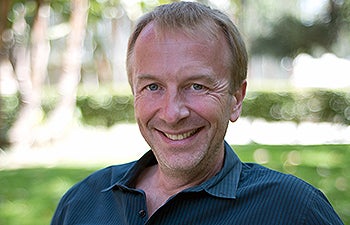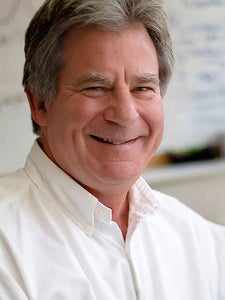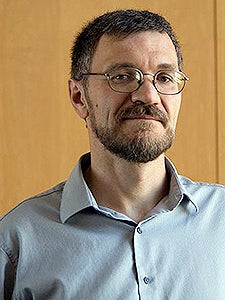USC Dornsife Recruits Renowned Leaders in Molecular Research
Raymond C. Stevens and Peter Kuhn have been named Provost Professor of Biological Sciences and Chemistry and Dean’s Professor of Biological Sciences, respectively. The announcements were made by Provost Elizabeth Garrett and USC Dornsife Dean Steve Kay.
Stevens and Kuhn are internationally renowned leaders in molecular research that merges disciplines to improve human health. Together their laboratories will bring a cohort of approximately 50 researchers to the university.
“Ray Stevens and Peter Kuhn are among the world’s most influential biomedical scientists, whose research on molecular structures and processes have led to important advances in medical treatments and pharmaceutical drugs,” Garrett said. “Their arrival enhances USC’s leadership in creating consequential research at the intersection of science and engineering.”


Kay also lauded Stevens and Kuhn, noting that the addition of their research groups is a major advancement for USC’s ongoing focus on shifting the life sciences from the descriptive to the predictive. 

“The recruitment of this elite team of inventive scientists helps propel the university’s focus on convergent bioscience and moves the needle for the entire medical field,” Kay said.



Raymond Stevens earned his Ph.D. in chemistry from USC Dornsife, where he worked with Distinguished Professor of Chemistry and 1994 Nobel Prize winner George Olah and the late Professor of Chemistry Robert Bau. Photo by Peter Zhaoyu Zhou.
Stevens pioneered the area of high throughput structural biology and structure-based drug discovery, which fuses engineering breakthroughs with classical research techniques to answer vital questions about human cellular behavior. He is also known for unlocking the structures of G protein-coupled receptors that serve as the cell’s gatekeepers and messengers. Their signals mediate nearly every essential physiological process — from immune system function to vision, taste and smell to cognition to heartbeat — and are essential for pharmaceutical drug development.
He helped create several therapeutic molecules that have become breakthrough drugs or are in clinical trials to treat conditions ranging from influenza to rare childhood diseases to neuromuscular disorders to diabetes. Stevens has also founded four successful biotechnology companies and three National Institutes of Health centers. A prolific scholar, he has authored more than 300 peer-reviewed publications. 

Stevens joins USC after serving as professor of molecular biology and chemistry at The Scripps Research Institute. He is the founding director of the iHuman Institute at ShanghaiTech University in China, where he is helping to build scientific bridges across the Pacific Rim. Thomson Reuters named Stevens among “The World’s Most Influential Scientific Minds” for 2014. 

“We came to USC because of the opportunity to converge the sciences and dramatically increase our understanding of the structure and function of the human body at the atomic scale,” Stevens said. “USC has the world’s No. 1 cinematic arts school, including expertise in digital art, which we think will be critical to bridging scientific and engineering disciplines.



Peter Kuhn co-leads one of the National Institutes of Health Physical Sciences Oncology Centers, which is shedding new light on how cancer spreads through the body. Photo by Peter Zhaoyu Zhou.
“With the university’s leadership committed to convergence combined with key recruitment and connecting a number of outstanding researchers at USC in chemistry, biology, physics, math, medicine and engineering, we can make a really big impact in basic scientific discovery, translational science and education,” added Stevens, who also holds joint appointments in neurology, and physiology and biophysics at the Keck School of Medicine of USC.
Stevens earned his Ph.D. in chemistry from USC Dornsife, where he worked with Distinguished Professor of Chemistry and 1994 Nobel Prize winner George Olah and the late professor of chemistry Robert Bau. Stevens conducted postdoctoral research in structural biology at Harvard University with 1976 Nobel Prize winner William Lipscomb before joining the chemistry and neurobiology faculty at the University of California, Berkeley.
Kuhn, who holds a joint appointment in medicine at the Keck School of Medicine, co-leads one of the NIH Physical Sciences Oncology Centers, which is casting new light on how cancer spreads through the body. Partnering with oncologists and engineers, including faculty at the Keck School and the USC Viterbi School of Engineering, Kuhn invented a method for detecting and characterizing cancer cells with a simple blood sample. 

The minimally invasive, blood-based fluid biopsy test Kuhn developed differentiates circulating tumor cells from ordinary blood cells using a digital microscope and image-processing algorithm. The breakthrough holds the potential for identifying people at risk for other conditions as well, including a heart attack. He founded the company Epic Sciences to bring such precision diagnostic technology from the academic laboratory to the marketplace.

James Hicks, professor (research) of biological sciences. Photo courtesy of James Hicks.
He also arrives from Scripps, where he established the translational science program. He previously served on the faculties of medicine and accelerator physics at Stanford University. As a scientist and entrepreneur, he has spent nearly two decades enabling and managing large-scale investigations that bring together interdisciplinary teams of physical, life and biomedical sciences researchers. 


Of the opportunity to expand his research and ongoing collaborations now that he is at USC, Kuhn said, “USC unites the best of the best, who all align on the vision of improving human health with scientific breakthroughs and bring outstanding scientific competencies to the table to make this vision a reality.”


A physicist by training, Kuhn initially studied at the Julius Maximilians Universität in Würzburg, Germany, before receiving his master’s and Ph.D. in physics at the University at Albany in New York. He has published more than 180 peer scientific articles and filed 16 patents.
Charles McKenna, vice dean for natural sciences, noted that the recruitment of Stevens, Kuhn and their colleagues underscores USC Dornsife’s continued development of top programs in the sciences.

Vadim Cherezov, professor of chemistry. Photo by Ryan Young.
“Ray’s brilliant research bridging chemistry and biology is creating a foundation for exciting new breakthroughs in understanding the human body and treating many diseases linked to human cell signaling,” McKenna said. “And Peter’s visionary work on the biology of cancer metastasis will place USC Dornsife at the center of an interdisciplinary research endeavor in the life, engineering and medical sciences with direct implications for human health.”


Soon joining Stevens and Kuhn at USC as professor (research) of biological sciences is James Hicks, their collaborator from Cold Spring Harbor Laboratory (CSHL), as well as two other colleagues from Scripps — Vadim Cherezov as professor of chemistry and Vsevolod “Seva” Katritch as assistant professor of biological sciences. 


A cancer genomicist, Hicks uses single cell genomics to characterize rare human cancer cells in blood and bone marrow of cancer patients. His important contributions to the methodologies required to understand the human response to cancer therapeutics involve highly innovative ways of using next-generation single cell sequencing to investigate the genetic basis of tumor heterogeneity. After beginning his academic career at CSHL and Scripps, Hicks spent 10 years in the biotechnology industry before returning to spend the last decade as a research professor at CSHL, along with serving as a board member at several biotech companies. He received his Ph.D. in molecular biology and genetics from the University of Oregon’s Institute of Molecular Biology and has published more than 100 research papers and seven patent filings.



Vsevolod “Seva” Katritch, assistant professor of biological sciences. Photo by Peter Zhaoyu Zhou.
Cherezov is a structural biophysicist whose work sheds light on the structure, stability and function of biological membranes. He has developed numerous novel instruments and technologies to enhance the biophysical characterization and crystallization of membrane proteins. His efforts are leading to ever-better ways of observing changes in proteins as they occur, and he leads an international, interdisciplinary collaboration in this area. Cherezov has published more than 90 research papers and filed five patent applications. He earned his Ph.D. in biophysics from the Moscow Institute of Physics and Technology.


Katritch is a computational biologist who develops and applies computational tools to the study of key biological phenomena, from chromatin folding to the molecular basis of signaling via membrane receptors. He works with crystallographers, biophysicists, molecular biologists and medicinal chemists at a number of institutions to unlock these proteins’ full potential as drug targets. Katritch completed his Ph.D. in biophysics and molecular biology at the Moscow Institute of Physics and Technology.


“The work of Stevens, Kuhn, Hicks, Cherezov, Katritch and their laboratories will open new avenues of discovery in basic science, novel educational approaches, and drug therapies and cures,” Kay said. “USC is honored to be their home, their headquarters and their partner in supporting future breakthroughs that enhance our understanding of the human body and that lead to dramatic improvements in health.”